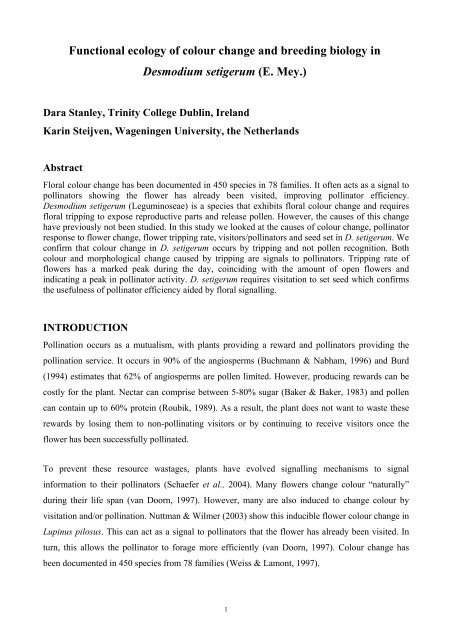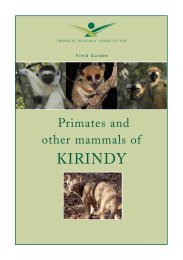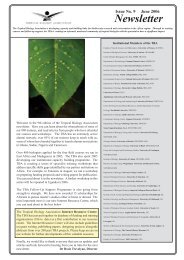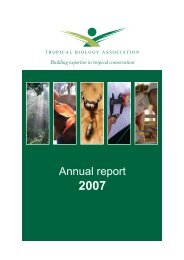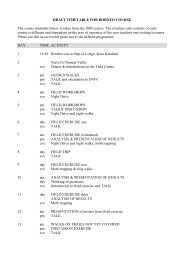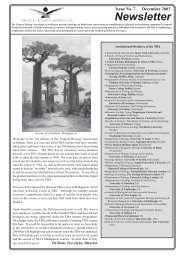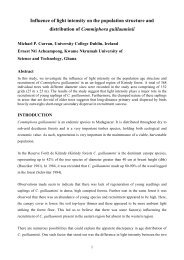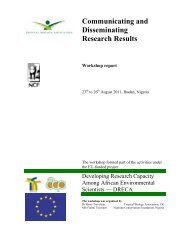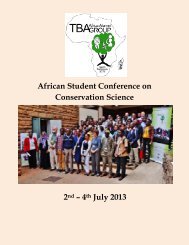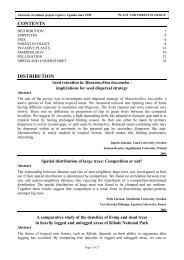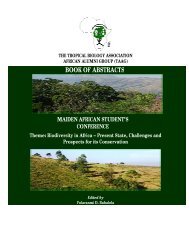Desmodium setigerum - Tropical Biology Association
Desmodium setigerum - Tropical Biology Association
Desmodium setigerum - Tropical Biology Association
Create successful ePaper yourself
Turn your PDF publications into a flip-book with our unique Google optimized e-Paper software.
Functional ecology of colour change and breeding biology in<strong>Desmodium</strong> <strong>setigerum</strong> (E. Mey.)Dara Stanley, Trinity College Dublin, IrelandKarin Steijven, Wageningen University, the NetherlandsAbstractFloral colour change has been documented in 450 species in 78 families. It often acts as a signal topollinators showing the flower has already been visited, improving pollinator efficiency.<strong>Desmodium</strong> <strong>setigerum</strong> (Leguminoseae) is a species that exhibits floral colour change and requiresfloral tripping to expose reproductive parts and release pollen. However, the causes of this changehave previously not been studied. In this study we looked at the causes of colour change, pollinatorresponse to flower change, flower tripping rate, visitors/pollinators and seed set in D. <strong>setigerum</strong>. Weconfirm that colour change in D. <strong>setigerum</strong> occurs by tripping and not pollen recognition. Bothcolour and morphological change caused by tripping are signals to pollinators. Tripping rate offlowers has a marked peak during the day, coinciding with the amount of open flowers andindicating a peak in pollinator activity. D. <strong>setigerum</strong> requires visitation to set seed which confirmsthe usefulness of pollinator efficiency aided by floral signalling.INTRODUCTIONPollination occurs as a mutualism, with plants providing a reward and pollinators providing thepollination service. It occurs in 90% of the angiosperms (Buchmann & Nabham, 1996) and Burd(1994) estimates that 62% of angiosperms are pollen limited. However, producing rewards can becostly for the plant. Nectar can comprise between 5-80% sugar (Baker & Baker, 1983) and pollencan contain up to 60% protein (Roubik, 1989). As a result, the plant does not want to waste theserewards by losing them to non-pollinating visitors or by continuing to receive visitors once theflower has been successfully pollinated.To prevent these resource wastages, plants have evolved signalling mechanisms to signalinformation to their pollinators (Schaefer et al., 2004). Many flowers change colour “naturally”during their life span (van Doorn, 1997). However, many are also induced to change colour byvisitation and/or pollination. Nuttman & Wilmer (2003) show this inducible flower colour change inLupinus pilosus. This can act as a signal to pollinators that the flower has already been visited. Inturn, this allows the pollinator to forage more efficiently (van Doorn, 1997). Colour change hasbeen documented in 450 species from 78 families (Weiss & Lamont, 1997).1
Often, pollinators cannot distinguish between these signals from long distances and so some plantsretain these older, colour changed flowers to act as extra long distance attractants (van Doorn,1997). When the pollinator is close up it then can differentiate between short distance signals andmay only visit the non-visited flowers.The longevity of some flowers is also affected by pollination and is also often linked with colourchange. Some species have flowers that wilt and die after pollination, but can persist for weekswithout pollination (van Doorn, 1997). This again aids pollinator efficiency by causing pollinatedflowers to wilt, signalling that they no longer want to be visited.The Leguminosae exhibit 23 genera where colour change is evident (Weiss, 1995). <strong>Desmodium</strong><strong>setigerum</strong> (Leguminosae) is a species that is observed to exhibit floral change colour. It alsorequires “tripping” by visitors to release pollen and expose the anthers and stigma (personalobservations). The flowers last only one day and some may have been observed to reopen followinginitial colour change (personal communication: Pat Wilmer). It is unknown whether the colourchange in this species is triggered by age, visitation or pollination.The aim of this study is to examine colour change and breeding biology in D. <strong>setigerum</strong> byinvestigating the following:• the effects of different pollen treatments on colour change and possible floral reopening ofD. <strong>setigerum</strong>.• the rate of colour change of D. <strong>setigerum</strong> in response to different pollen treatments• the signal of colour change in D. <strong>setigerum</strong> to pollinators• the morphological signal of flower tripping in D. <strong>setigerum</strong> to visitors• the pattern of tripping throughout the day• the effects of different pollen treatments on seed set of D. <strong>setigerum</strong>MATERIALS AND METHODSStudy species<strong>Desmodium</strong> <strong>setigerum</strong> E. Mey. (Leguminosae, Papillionoideae) is a herbaceous, climbing perennial.It has trifoliate leaves with silvery centre. Stems and seed pods are sticky and adhesive. Flowers arehomomorphic, lilac coloured turning blue with time, and occur on terminal spikes. Flowers last forone day and require tripping by visitors to expose reproductive parts. D. <strong>setigerum</strong> occurs alongpathways and in higher light conditions in Kibale National Park, Uganda.2
Study areaThis research was conducted in Kibale National Park (766 km 2 ) in western Uganda situated at thefoothills of the Rwenzori mountains. Kibale’s coordinates are 0˚13’-0˚41N and 30˚19’-30˚32E(Lwanga, 2003). The national park is classified to be moist semi-deciduous and evergreen rainforest(Wrangham et al., 1994). The altitudes of the national park range from 1590 m to 990 m(Wrangham et al. 1994). The research site was situated in the southern part of the park near theMUBFS research station, close to the village of Kanyawara. Kanyawara’s altitude is approximately1500 m. Average annual rainfall is 1700mm (1984-1996) (Chapman et al. 1999). The averageminimum temperature is 15 ˚C, average maximum is 20 ˚C (Chapman et al. 1999). In this project,D. <strong>setigerum</strong> was studied along the path that goes from MUBFS field station to the soccer pitch andinto the regenerating forest.Colour change experimentTo investigate floral colour change in D. <strong>setigerum</strong>, six pollination treatments were applied asfollows:1. self pollen (hand pollinated)2. cross pollen (hand pollinated)3. naturally tripped (by visitors)4. manually tripped, no pollen (positive control)5. not tripped (negative control)6. heterospecific pollen (Ipomea spp.)Each treatment was applied to six flowers, each flower occurring on a different inflorescence,resulting in a total of 18 replicates. The flowers in treatments 1-4 were first tripped by inserting apin near the base of the stigma. The flowers in treatment 5 (negative control) were bagged toprevent flowers being tripped by pollinators. This experiment was carried out at three sites on threedifferent days.When the treatments were applied, the colour of the flowers was recorded hourly, from 10 am until5 pm. Colour change was scored on an ordinal scale. Anther position and degree of floral opennesswere also recorded.3
Pollinators and pollinator response to colour changeTo investigate pollinators of and visitation to D. <strong>setigerum</strong>, observations were carried out in threesites on three different days between 10 am-5 pm. Visitors, numbers of visits, numbers of flowersvisited and colour of flowers visited were recorded.Pollinator response to morphological changeTo determine whether the morphological change after tripping is a signal to pollinators, visitation toboth tripped and untripped flowers was investigated. Five sites were selected and at each site aneven number of flowers were mapped. Half of the flowers were manually tripped and half remaineduntripped. All flowers were observed over the course of time it took for the tripped flowers tocompletely change colour. The numbers of visits and approaches to tripped and untripped flowerswere counted.Tripping rateTo determine the rate at which D. <strong>setigerum</strong> flowers were visited, two transect walks were carriedout. Every hour, from 8 am to 6 pm, all receptive tripped and untripped flowers on the transect linewere counted.Seed set experimentTo examine seed set of D. <strong>setigerum</strong>, 5 pollination treatments were applied (1-5 as above) in 9 sites.Each treatment was applied to 6 flowers, each flower occurring on a different inflorescence,resulting in a total of 54 replicates. The treated flowers were left for 5 days. The seeds were thencollected and counted back in the lab.Statistical analysisFor all the statistical analyses the statistical package MINITAB was used. Where data was normallydistributed ANOVA’s were carried out followed up by a Tukey post-hoc test. For data that was notnormally distributed a Kruskal-Wallis test was used. In the pollinator response to morphologicalchange experiment a Chi-square test was carried out. To test for correlations in the colour changeexperiment a Spearman rank test was used.4
RESULTSColour changeThe lifespan of D. <strong>setigerum</strong> flowers is one day and all flowers were observed to change colourthroughout the day. Colour change differs between tripped and untripped flowers. The stages ofcolour change of tripped flowers was as follows:1. Lilac – an open flower not yet visited,2. Lilac visited – an open, tripped flower3. Lilac pale – first signs of colour change4. White over blue/lilac – white flag and blue/lilac keel5. White over blue – white flag over blue keelStage 5 was the final stage. Some flowers were recorded as blue as the flag was bent back but thiswas most likely due to morphological damage. In stage 1 the flowers are fully open with anthersvisible in centre. By stage 5 the flowers are fully closed with anthers under flag (Table 1). Flowercolour is positively correlated with both anther position (Spearman Rank Correlation: Ps = 0.741,p120 degrees3 Lilac pale First sign of pollen Tripped in middle >100 degreeschange4 White over blue/lilac White flag over blue/lilac Hidden under 80-90 degreeskeellowering flag5 White over blue White flag over blue keel Hidden underlowered flag80 degrees orlessThe stages of colour change in untripped flowers differ from tripped as follows:1. Lilac – an open flower not yet visited2. Blue over lilac – an open flower with blue flag over lilac keel3. White over blue – a white flag over a blue keel.5
Stage 3 was not recorded in our observation period but was noted the following morning in allcases.Fig. 1 shows the percentage of all the colour stages of both tripped and untripped flowers as theyoccur during the day.% each colour100%90%80%70%60%50%40%30%20%10%0%9 10 11 12 13 14 15 16 17white over bluewhite over blue/lilaclilac visited palelilac visitedblueblue over lilaclilac palelilacTimeFigure 1. The percentage of flowers in each colour category over time in D. <strong>setigerum</strong>.In order to compare the different rates of colour change among treatments, the time taken to changefrom stage 1 (lilac) to stage 5 (white over blue) was calculated. As the flowers in the untrippedtreatment never reached the final stage during our observation period, we assumed 6 pm as their endpoint. However, it is likely these flowers took longer to complete their colour change.The time taken to complete colour change varied significantly among pollen treatments (One-wayANOVA: F 5,107 =428.83, p
Time to complete colour change(hrs)109876543210naturallyvisitedtripped with nopollenself-pollen cross-pollen heterospecificpollenuntrippedTreatmentFig. 2 The mean time to complete colour change from “lilac” to “blue over white” in D. <strong>setigerum</strong> flowers foreach pollen treatment.Pollinators and pollinator response to colour changeA wide variety of visitors were seen to visit D. <strong>setigerum</strong> flowers. Bees were the only visitorscapable of tripping the flowers. Fifteen bee species were caught tripping D. <strong>setigerum</strong> flowers and anumber of others were also observed.There was a huge range in size of bee capable of triggering the tripping mechanism. Observedtripping visitors ranged from small bees (
% visits80706050403020100lilac lilac pale blue/whitecolourFig. 3 The percentage of visits to D. <strong>setigerum</strong> flowers in each of three colour categories. “Lilac” categorycontains colour stages 1-2, “Lilac pale” contains stage 3 and blue/white contains stages 4-5.Pollinator response to morphological changeAlthough visitors appeared to have a preference for lilac flowers, there was a marked difference intheir response to whether the flowers were tripped or untripped. Untripped flowers receivedsignificantly more visits than tripped flowers. However, tripped flowers were approached moreoften than tripped flowers (χ 2 =104.56, df=1, p
Tripping rateDuring the day there was a peak in number of tripped flowers. Early in the morning the majority offlowers were closed. By 11am most buds had opened. By this time visitors appeared most active asthe highest number of flowers were tripped (Fig. 5). Tripping visitation appears to peak between9 am to 12 pm.Flowers that were tripped and still open with some degree of lilac were recorded as tripped. As aresult, the number of tripped flowers decreased during the day as flowers completed their colourchange.1200No. flowers1000800600400200007:30 08:45 10:00 11:15 12:30 13:45 15:00 16:15 17:30 18:45TimeUntrippedtransect 1Trippedtransect 1Untrippedtransect 2Trippedtransect 2Fig. 5 The number of tripped and untripped flowers from 8am to 6pm on 2 transect lines.Seed setSeed set varied significantly among the pollen treatments applied (Kruskal-Wallis, H=43.52, df=4,p
43.5mean no. seeds32.521.510.50naturally trippedtripped with nopollenself-pollen cross-pollen untrippedTreatmentFig. 6 Seed set under five different pollen treatments. “naturally tripped” n=56, “tripped with no pollen” n=53,“self-pollen” n=49, “cross-pollen” n=49, “untripped” n=56.CONCLUSION AND DISCUSSIONThis study confirms that colour change in D. <strong>setigerum</strong> occurs by tripping and not pollenrecognition. Colour and morphological change are signals to pollinators. Tripping rate of flowershas a marked peak coinciding with the amount of open flowers indicating a peak in pollinatoractivity. D. <strong>setigerum</strong> requires visitation to set seed and although can set seed with self pollen, doesnot self pollinate.Colour change in D. <strong>setigerum</strong> is an induced reaction. As in other documented species (Nuttman &Willmer, 2003), colour change is induced by visitation. In D. <strong>setigerum</strong>, it is the act of tripping andnot pollen deposition that causes the floral colour change to accelerate. Therefore the plant maychange colour even if not pollinated as the tripping mechanism and not pollen recognitionstimulates colour change. However, tripping without some degree of pollen deposition is unlikely astripping without visitation does not occur. Colour change is also induced at a much slower rate byfloral ageing. As these flowers last for only one day, colour change without tripping occurs near theend of the lifespan of the flower.The rapid colour change in D. <strong>setigerum</strong> flowers allows the plant to signal to its pollinators. Allflowers begin the day with an equal attractiveness as they are all lilac. During the day, those flowersthat were tripped change colour and become less attractive, increasing the chances of their unvisitedneighbours to be pollinated.10
Van Doorn (1997) suggests induced floral colour change does not exist in flowers that last only oneday. He states that such rapid change would not increase effectiveness of pollination as the lifespanof the flower is already so short. In D. <strong>setigerum</strong>, however, we find rapid colour change in flowersthat last only one day. Colour change in most flowers is a signal to pollinators that pollination hasoccurred but may also be to reduce maintenance cost of the flowers (van Doorn, 1997). In D.<strong>setigerum</strong>, colour change must increase effectiveness of pollination as it cannot reduce maintenancecost of the flowers as they already live for such a short period.Before colour change occurs, floral morphology also acts as a signal to pollinators. From a longdistance, visitors appear unable to distinguish between tripped and untripped flowers and the largerdisplay attracts more visitors. From a short distance, the morphological signal of flower tripping isrecognised and tripped flowers are rarely revisited. The visitor would approach to within 1cm of atripped flower without consequently landing on the flower. This long distance attraction withdifferent signals close up in commonly found in plants that change colour, increasing pollinatorsattraction but without losing pollinator efficiency and reducing geitonogamy (van Doorn, 1997,Weiss, 1995).This dual signalling in D. <strong>setigerum</strong> creates an effective overall signal to visitors. Very few visitorswere recorded to visit flowers displaying either of these signals. This dual signalling must increasepollinator efficiency, as suggested by the extremely small number of untripped flowers that remainat the end of the day.The signalling mechanisms in this species may be necessary as the plant requires visitation to setseed. Untripped flowers usually do not set seed, nor do tripped flowers without a visitor showingthe plant does not self pollinate. This is due to the fact that pollen is released in an explosive fashiononly after tripping. The explosive pollen release in this species prevents self pollination as pollen isdispersed away from the flower. D. <strong>setigerum</strong> is, however, capable of setting seed equally with selfand non-self pollen showing it does not have a homomorphic self-incompatibility mechanism, butas pollen explosion requires tripping self pollination would rarely occur.This species is visited and tripped by a large range of bee species. These visitors have a huge rangein body size, from very small bees (
would still give out signals that it has been pollinated but would only be tripped and not havereceived any pollen.For further studies, it would be interesting to investigate which pollinators are the most effective.Also, further study on the pollinator response to the signals of D. <strong>setigerum</strong> flowers would bebeneficial. This could investigate whether different pollinators respond differently on a moresensitive scale to these signals. Secondly, this could gain insight into how pollinator efficiency andsignalling mechanisms are related.This study has provided baseline ecological information on the signalling and breeding biology ofD. <strong>setigerum</strong>. This species, with short floral longevity, has a surprisingly complex set of floralsignalling mechanisms to visitors. These signals appear to be effective in increasing thereproductive success of the plant. Further studies on other species would be interesting to see if thisis a common or indeed unique occurrence.ACKNOWLEDGEMENTSWe would like to thank our supervisor Dr. Clive Nuttman for his help and support and Prof. PatWillmer for her advice, ideas and preliminary work. We would also like to thank all TBA andMUBFS staff for assistance during this project. We would like to acknowledge the financialassistance of the British Ecological Society, Wageningen Universiteits Fonds and the AlbertaMennega Stichting, who aided attendance on this TBA course. Finally we would like to mention allour fellow TBA participants – bhí an craic againn! Houdoe en bedankt!12
REFERENCESBaker, H.G. & Baker, I. (1983) A brief historical review of the chemistry of floral nectar. InBentley B & Elias, T. (eds). The biology of nectaries. Columbia Univ. Press, New York. p.126-152.Buchmann, S.L. & Nabhan, G.P. (1996) The forgotten pollinators. Island Press, USA.Burd (1994) Bateman’s principle and plant reproduction: the role of pollen limitation in fruit andseed set. Botanical Review 60:83-139Chapman, C.A., Wrangham, R.W., Chapman, L.J., Kennard, D.K. and Zanne, A.E. (1999) Fruit andFlower Phenology at Two Sites in Kibale National Park, Uganda. Journal of <strong>Tropical</strong> Ecology, 15-2:189-211.Van Doorn, W.G. (1997) Effects of pollination on floral attraction and longevity. Journal ofExperimental Botany, 48:1615-1622.Lwanga, J.S. (2003) Forest succession in Kibale National Park, Uganda: implications for forestrestoration and management. African Journal of Ecology. 41:9-22.Nuttman, C. & Willmer, P. (2003) How does insect visitation trigger floral colour change?Ecological Entomology 28:467-474Roubik, D.W. (1989) Ecology and natural history of tropical bees. Cambridge University Press,UK.Schaefer, H.M., Schaefer, V. and Levey, D.J. (2004) How plant-animal interactions signal newinsights in communication. TREE 19:577-584.Weiss, M.R. (1995) Floral colour change: a widespread functional convergence. American Journalof Botany, 82:167-185.Weiss, M.R. & Lamont, B.B. (1997) Floral colour change and insect pollination: a dynamicrelationship. Israel Journal of Plant Sciences, 45:185-200.Wrangham, R.W., Chapman, C.A. and Chapman, L.J. (1994) Seed dispersal by forest chimpanzeesin Uganda. Journal of <strong>Tropical</strong> Ecology 10:355-368.13


